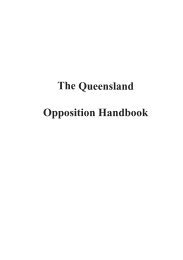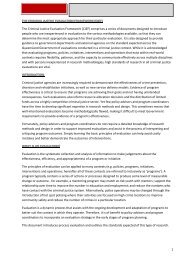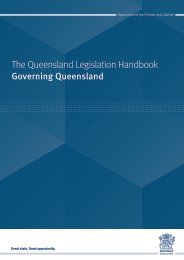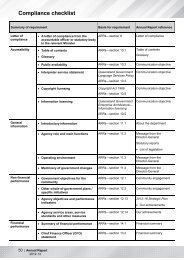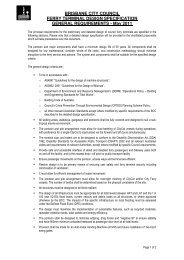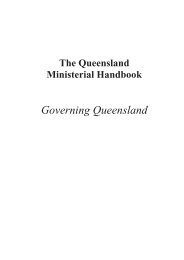Rehabilitative needs and treatment of Indigenous offenders in ...
Rehabilitative needs and treatment of Indigenous offenders in ...
Rehabilitative needs and treatment of Indigenous offenders in ...
You also want an ePaper? Increase the reach of your titles
YUMPU automatically turns print PDFs into web optimized ePapers that Google loves.
Chapter 4<strong>Indigenous</strong> Offender Pr<strong>of</strong>ile <strong>in</strong> Queensl<strong>and</strong>This chapter provides an overview <strong>of</strong> selected characteristics <strong>of</strong>Queensl<strong>and</strong> <strong>Indigenous</strong> <strong>of</strong>fenders. It is observed that <strong>Indigenous</strong><strong>of</strong>fenders are over-represented <strong>in</strong> custody <strong>and</strong> have a different <strong>of</strong>fencepr<strong>of</strong>ile from non-<strong>Indigenous</strong> <strong>of</strong>fenders. These differences are likely toimpact on the rehabilitation <strong>needs</strong> <strong>of</strong> <strong>Indigenous</strong> <strong>of</strong>fenders. 5<strong>Indigenous</strong> Over-Representation <strong>in</strong> Queensl<strong>and</strong> Custody<strong>Indigenous</strong> persons currently represent three per cent <strong>of</strong> Queensl<strong>and</strong>’sgeneral population, nearly 30 per cent <strong>of</strong> the prisoner population <strong>and</strong>approximately 20 per cent <strong>of</strong> <strong>of</strong>fenders under community supervision.<strong>Indigenous</strong> over-representation is also evident <strong>in</strong> imprisonment rates. In 2008,<strong>Indigenous</strong> persons were 11 times more likely to be <strong>in</strong>carcerated than non-<strong>Indigenous</strong> persons (ABS 2008). The over-representation <strong>of</strong> <strong>Indigenous</strong><strong>of</strong>fenders <strong>in</strong> custody is evident <strong>in</strong> other Australian jurisdictions (ABS 2008).Figure 4.1 shows how the over-representation <strong>of</strong> <strong>Indigenous</strong> <strong>of</strong>fenders has<strong>in</strong>creased s<strong>in</strong>ce 2000. This <strong>in</strong>crease occurred despite the sign<strong>in</strong>g <strong>of</strong> theQueensl<strong>and</strong> Aborig<strong>in</strong>al <strong>and</strong> Torres Strait Isl<strong>and</strong>er Justice Agreement <strong>in</strong> 2000which set out to reduce the rate <strong>of</strong> <strong>Indigenous</strong> persons com<strong>in</strong>g <strong>in</strong>to contactwith the crim<strong>in</strong>al justice system to at least the same rate as non-<strong>Indigenous</strong>persons. <strong>Indigenous</strong> <strong>of</strong>fenders represented approximately 23 per cent <strong>of</strong> thetotal prisoner population at December 2000 compared with approximately 29per cent at December 2010. The <strong>Indigenous</strong> <strong>of</strong>fender population <strong>in</strong>creased by59 per cent <strong>in</strong> the period between December 2000 <strong>and</strong> December 2009 whilethe total prisoner population <strong>in</strong>creased by 27 per cent. The overrepresentation<strong>of</strong> <strong>Indigenous</strong> <strong>of</strong>fenders <strong>in</strong> custody is driven <strong>in</strong> part by a rise <strong>in</strong>the number <strong>of</strong> <strong>Indigenous</strong> <strong>of</strong>fenders on rem<strong>and</strong>. 6 Increases <strong>in</strong> <strong>Indigenous</strong>over-representation are greatest after June 2004. The number <strong>of</strong> <strong>Indigenous</strong><strong>of</strong>fenders on rem<strong>and</strong> <strong>in</strong>creased by 65 per cent between December 2004 <strong>and</strong>December 2009 compared with a 24 per cent <strong>in</strong>crease for the total prisonerpopulation.5 The <strong>in</strong>formation provided <strong>in</strong> this chapter is derived from various sources. Some data isadmissions-based, while other data refer to a po<strong>in</strong>t <strong>in</strong> time. Admissions-based data producesa higher number <strong>of</strong> <strong>of</strong>fenders than ‘as at’ data because it counts the total number <strong>of</strong> <strong>of</strong>fendersadmitted <strong>in</strong>to custody dur<strong>in</strong>g a certa<strong>in</strong> time period; ‘as at’ data counts the number <strong>of</strong> <strong>of</strong>fenders<strong>in</strong> custody at a certa<strong>in</strong> po<strong>in</strong>t <strong>in</strong> time. Admissions-based data is sensitive to the turnover <strong>of</strong>short-term <strong>of</strong>fenders enter<strong>in</strong>g <strong>and</strong> exit<strong>in</strong>g custody.6 Readers are advised the rem<strong>and</strong> <strong>in</strong>formation provided <strong>in</strong> this report is likely to over-state therem<strong>and</strong> population size due to data issues outl<strong>in</strong>ed <strong>in</strong> Chapter two.24



